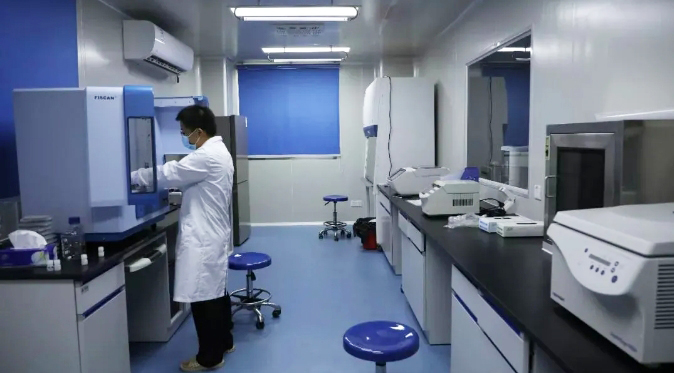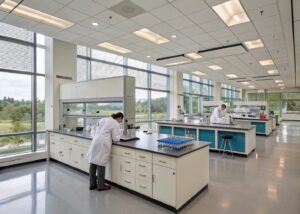Table of Contents
Setting up a forensic lab requires careful planning, attention to detail, and a deep understanding of how to incorporate key components such as DNA detection systems into the design. Whether you’re setting up a new forensic lab or upgrading an existing one, integrating DNA detection technology is essential for modern criminal investigations. This article will guide you through the purpose of DNA detection in forensic lab design, providing insights into the layout, equipment, and systems that make the process efficient, reliable, and legally admissible.
Why DNA Detection is Central to Forensic Lab Design
DNA detection has become the cornerstone of forensic science, offering an unparalleled ability to identify individuals with accuracy. In forensic labs, DNA testing helps in solving a wide range of cases, from violent crimes like homicide to non-violent crimes such as property theft. This makes the proper design and layout of a forensic lab critical to ensure the accurate collection, amplification, and analysis of DNA samples.
Key Functions of DNA Detection in a Forensic Lab
The design of a forensic lab must prioritize the following key DNA detection functions:
DNA Extraction: This process isolates DNA from biological material, such as blood, hair, or tissue. A well-designed forensic lab will have a dedicated DNA extraction room that is separated from other areas to prevent contamination.
PCR Amplification: DNA samples are often too small to be directly analyzed, so they need to be amplified through Polymerase Chain Reaction (PCR). PCR amplifies specific DNA regions, making them detectable for forensic scientists.
DNA Analysis and Detection: Fluorescent DNA detection technology is used to screen and analyze DNA samples after amplification. It is critical that this area is equipped with high-throughput DNA analyzers and detection systems to ensure fast and accurate results.
Forensic Lab Design: Essential Areas and Layout
The layout of a forensic lab plays a pivotal role in ensuring that DNA testing procedures are conducted in a clean, contamination-free environment. Here are the most essential areas to consider when planning your forensic lab design:
Reception and Sample Intake Area
The sample intake area is the first point of contact for biological samples. This space should be kept separate from the testing areas to prevent cross-contamination. A secure chain of custody should also be maintained from the moment the evidence is received until the final report is generated.
DNA Extraction Area
As one of the most critical zones in any forensic lab, the DNA extraction area must be designed to minimize the risk of contamination. It should be equipped with biosafety cabinets and air purification systems. This area must also be separate from where PCR amplification and DNA analysis are conducted to prevent the transfer of DNA between samples.
PCR Amplification Room
The amplification area should be completely isolated from the DNA extraction and analysis zones. This space is where DNA samples are multiplied, and even the smallest contamination can lead to inaccurate results. Designing this area with strict environmental controls, such as negative pressure and air filtration, will help maintain the integrity of the DNA samples.
DNA Detection and Analysis Zone
This zone is where fluorescent DNA detection and analysis take place. Advanced DNA sequencing machines and analyzers are typically used here. This area should be equipped with state-of-the-art technology to ensure precise and efficient processing of DNA samples.
Reagent and Sample Storage
Both reagents and biological samples must be stored in optimal conditions to ensure they remain viable for testing. Cold storage units, clean, dry environments, and secure facilities are essential for long-term storage in a forensic lab.
Office Space and Data Analysis
In addition to the technical workspaces, the lab should have designated areas for reporting, data analysis, and administrative work. In this space, forensic scientists review the results of DNA tests, prepare reports, and maintain records for case files.
Grading and Standards for Forensic DNA Labs
In the world of forensic science, laboratories are often graded based on their size, capacity, and capabilities. Whether you are setting up a small-scale lab or a state-of-the-art facility, following industry standards is crucial to ensure that your forensic lab design meets legal and technical requirements.
Level Three: Basic Forensic Lab Design
A level three forensic lab focuses on basic DNA testing capabilities. It must meet essential technical standards, including designated areas for sample intake, DNA extraction, PCR amplification, and analysis. The total area required is at least 130 square meters. The layout must allow for one-way workflow, preventing contamination and ensuring the integrity of the DNA analysis.
Level Two: Advanced Forensic Lab Design
A level two forensic lab is designed for larger case loads and requires at least 300 square meters of space. It includes separate areas for handling samples from both crime scenes and personnel, along with dedicated air purification and independent exhaust systems. A level two lab is equipped to handle more complex biological samples, such as bones or trace DNA.
Level One: State-of-the-Art Forensic Lab Design
Level one forensic labs must be designed to accommodate advanced DNA testing techniques, including the ability to process challenging biological samples and contribute to research in DNA technology. These labs typically cover over 800 square meters and are outfitted with automation workstations, research facilities, and high-capacity DNA analyzers.
Forensic Lab Equipment: What You Need for DNA Testing
The equipment you choose for your forensic lab will directly impact its functionality and efficiency. Key equipment includes:
- High-throughput DNA Analyzers: Essential for processing large volumes of DNA samples quickly and accurately.
- PCR Amplifiers: Used to amplify DNA samples for analysis.
- Centrifuges, Incubators, and Oscillators: Necessary for preparing samples before testing.
- Biosafety Cabinets: To protect samples and personnel during DNA extraction.
- Refrigerators and Freezers: For storing sensitive biological materials and reagents.
Regular maintenance and calibration of all equipment are vital to ensure optimal performance and avoid cross-contamination.
Conclusion
Designing a forensic lab with a focus on DNA detection is a highly specialized task that requires attention to detail, strict adherence to technical standards, and a comprehensive understanding of forensic workflows. Whether you’re setting up a small-scale or advanced lab, your forensic lab design must prioritize contamination control, one-way sample flow, and proper equipment placement to ensure accurate DNA testing. By carefully planning the layout and equipping your lab with the necessary tools, you will create a forensic lab that can reliably process DNA samples for criminal investigations, contributing to the pursuit of justice.




